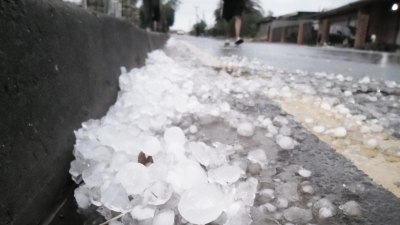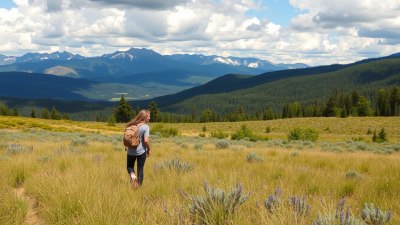How Hailstones Grow So Large
Discover the fascinating process of hailstone formation and how they grow larger during thunderstorms.

Hailstones are a captivating meteorological phenomenon, known for their ability to grow to remarkable sizes within thunderstorms. The formation of these icy spheres is a complex process that involves several conditions and atmospheric dynamics. In this article, we will explore how hailstones grow, the conditions necessary for their development, and the science behind their impressive sizes.
The Basics of Hail Formation
The formation of hail begins in strong thunderstorms, particularly those that exhibit a specific type of cloud known as a cumulonimbus cloud. These clouds are characterized by their towering structure and the ability to create strong updrafts and downdrafts. The key conditions for hail formation include the presence of supercooled water droplets, high levels of moisture in the atmosphere, and sufficient vertical wind shear. Supercooled water is water that exists in a liquid state at temperatures below freezing, and it plays a critical role in the growth of hailstones.
The Role of Updrafts
As thunderstorms develop, powerful updrafts can reach speeds of over 100 miles per hour. These updrafts lift particles, including water droplets and ice nuclei, high into the colder regions of the cloud, where temperatures are below freezing. Once the supercooled droplets are carried upward, they freeze upon contact with these ice nuclei, forming small hailstones. The strength of the updraft is crucial; stronger updrafts can elevate hailstones to higher altitudes where temperatures dip even further, promoting further growth.
Layering Process
As hailstones are lifted and suspended in the cloud, they are subjected to repeated cycles of freezing and melting. The intense updrafts keep these stones aloft, while the surrounding supercooled water droplets continue to freeze onto their surfaces. This layering process can create hailstones of considerable size. With each cycle, the hailstone's mass increases, as it garners more layers of ice around it. These cycles depend greatly on the strength of the updrafts and the amount of available supercooled water. The larger the hailstone becomes, the greater the challenges it faces in being sustained within the cloud.
Downdrafts: The End of Hail Growth
As hailstones grow larger, they eventually reach a point where the strong updrafts can no longer support their weight. When this happens, they fall toward the ground, typically accompanied by downdrafts. Downdrafts occur when cooler air descends through the storm cloud, and they can contribute to the eventual release of hailstones. During their descent, hailstones may collide with smaller ice pellets or be subjected to further melting if they pass through warmer air layers. The size of hailstones can decrease during descent as they lose some of their accumulated ice.
Factors Influencing Hail Size
Several factors influence the final size of hailstones. Primarily, the strength of the updrafts plays a critical role; stronger updrafts are capable of supporting larger hailstones for longer periods, facilitating more growth. Additionally, the availability of supercooled water is essential—storms with abundant moisture and high humidity levels tend to produce larger hailstones. Environmental conditions such as storm longevity, the temperature profile of the atmosphere, and the geographic location of the storm also contribute to hail size. For instance, regions that experience severe thunderstorms, such as the Great Plains in the United States, are particularly known for producing larger-sized hail.
The Composition of Hailstones
Hailstones typically appear as layered spheres of ice, with a nucleus of frozen water at their center. The layers formed during their growth can exhibit clear and opaque bands, indicating cycles of freezing and melting. Clear ice is formed when the water droplets freeze gradually, while opaque ice results from more rapid freezing, trapping tiny air bubbles. The composition and structure of hailstones provide valuable insights into how they formed and the atmospheric conditions present during their development.
Hail Size Records
Hailstones can vary dramatically in size. While many hailstones are relatively small, measuring just a few millimeters in diameter, some have grown to sizes that are astonishing. The largest hailstone on record in the United States fell in Aurora, Nebraska, in 2003, measuring an impressive 8 inches in diameter. Such extreme instances highlight the capacity for hailstones to reach extraordinary dimensions depending on the underlying atmospheric conditions during their formation.
Impacts of Large Hailstones
While the study of hailstone formation is academically intriguing, the impacts of large hailstones extend far beyond understanding meteorology. Hail can cause significant damage to crops, vehicles, buildings, and infrastructure. In agriculture, hail can decimate crops, leading to severe economic losses for farmers. Furthermore, hail can damage roofs and siding, leading to costly repairs and rebuilding efforts. Insurance claims related to hail damage often surge after severe storms, prompting further interest in better forecasting and understanding of hail-producing storms.
Preventing Hail Damage
Given the potential for hail damage, researchers and meteorologists are continuously exploring methods to mitigate its impact. One approach involves developing more accurate forecasting models that can predict where and when hail is likely to occur. Additionally, advancements in technology, such as radar and satellite imagery, enhance our ability to monitor storm development in real-time, providing valuable information for issuing warnings. Some studies have even explored innovative concepts such as cloud seeding to disrupt the formation process of hailstones, although the effectiveness of such methods remains variable.
Future of Hail Research
As climate change continues to affect weather patterns, understanding hailstone formation and its mechanisms will become increasingly important. Shifts in temperature, humidity, and storm dynamics may lead to changes in the frequency and intensity of hail-producing storms. Increased research efforts will focus on refining our understanding of these changes and their implications for the future. Continuous advancements in weather observation technologies hold the promise of enhancing predictive capabilities, providing better preparedness for communities prone to severe weather.
In conclusion, the growth of hailstones is a fascinating interplay of atmospheric dynamics that unfolds within the robust environment of a thunderstorm. Understanding the processes by which hailstones develop not only enhances our knowledge of weather phenomena but also aids in preparing for the impacts of severe weather events. The size and structure of hailstones serve as reminders of the incredible forces of nature at play in our atmosphere. By continuing to study hail formation and associated storm conditions, we can work toward better predicting and mitigating the hazards posed by hailstorms, ultimately safeguarding lives and property.











